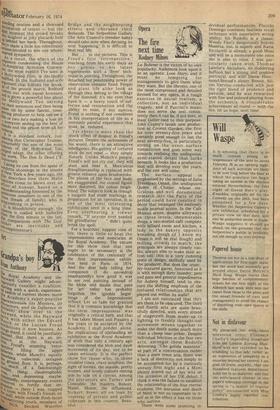krt
randpa's boy
Anthony
The lia Royal Academy and the ra-Yward Gallery might advan4eously consider a coalition, tevrtifig with a quick, experimenrheswitch of current shows: move /41 Academy's super-positive NPressionism (its Masters, its e.cursors, and its Influence in ILItain) show over to the h;YWard, while the Hayward lets with either the Edvard ektitIn.cb or the Lucian Freud lbitions it now houses. As ei:Igs stand, it could be justifiably hil'ffled that there is an im41,nee at the Hayward, 41t' Freud's stunning 'retro Coctive' filling the upper 41-zZ.,effkes. while Munch's equally the-ruing collection occupies th) ground floor. It is, perhaps, 44,, Much of a fascinatingly eve–,,ure thing; claustrophobic and depressing maybe. Cn-attedly, contemporary events pr :ed to fortify that im Itle,"sion there I was, trapped the room with Freud's friends on der all, while outside fresh-faced the"f4lstrating youth, members of
Bridge and the neighbouring streets and chorused their demands. The Serpentine Gallery (the Arts Council's trendier baby) should take note when devising its next 'happening.' It is difficult to beat real life.
But . . . to the pictures. This is Freud's first 'retrospective,' reaching from his early days as boy genius to his latest experiments with a 'freer' technique in painting. Throughout, the detached but penetrating power of observation remains fixed. People and plant life alike look as through they belong to the village of the damned; it's the eyes that have it — a heavy touch of sufferine and resienation and the ability to exist, if not survive. Freud is nothing if not consistent in his interpretation of life as a seriously painful experience that must be endured.
Yet there is more than the shock effect of despair in Freud's pictures. Despite the airlessness of his world, there is an attractive intelligence. His gallery of tortured souls do not repel — they simply disturb. Unlike Munch's people, Freud's will not cry out; they will start and bear it. Meticulous draughtsmanship is replaced with greater reliance upon brushstroke. The planes of the face and body are exaggerated, the overall figure more distorted, the colour heightened. The subjects look as though a surgeon had made markings in preparation for an operation. It is one of the most interesting exhibitions seen in a long time. Even overhearing a viewer remark, "If anyone ever needed his grandfather . . ." didn't quite break the spell.
For a healthier, happier view of file, there is little to beat the impressionists and associates at the Royal Academy. The excuse for this show (not that one ought to be necessary) is the celebration of the centenary of the first impressionist exhibition held in Paris in 1874. And the dear lady telling her companion (I do eavesdrop unashamedly) how good it was to see real painting instead of the blobs and daubs that pass for 'art' today has probably forgotten the ignoble beginnings of the Impressionist school. Let us take for granted that it is common knowledge that the term 'impressionist' was originally a critical barb, and that it has taken Monet and Pissarro a few years to be accepted by the Academy. I shall ponder, alone, the implications of applauding an exhibition at the Royal Academy of work that only a century ago was considered the blob and daub movement of its day, not to be taken seriously. It is the perfect show for those who, in these troubled times, crave sunshine, the sight of forests, the seaside, pretty women, and lovely colours resting side by side on a canvas. Among the precursors are Turner and Constable; the masters, Renoir, Manet, Monet; the influenced, Sickert, Steer; all on loan by courtesy of private and public collectors in this country. Beautiful.


































 Previous page
Previous page